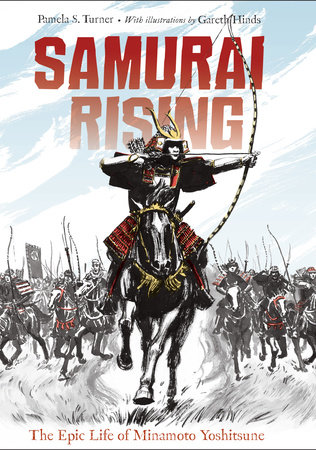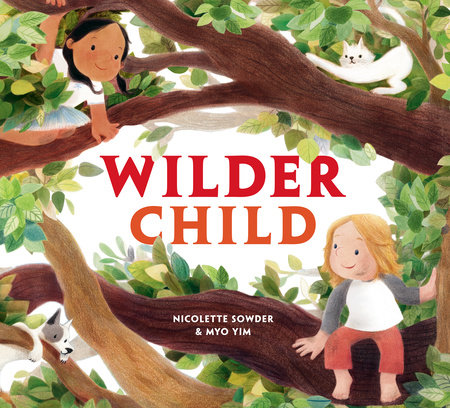

Samurai Rising
By Pamela S. Turner
Illustrated by Gareth Hinds
By Pamela S. Turner
Illustrated by Gareth Hinds
By Pamela S. Turner
Illustrated by Gareth Hinds
By Pamela S. Turner
Illustrated by Gareth Hinds
By Pamela S. Turner
Illustrated by Gareth Hinds
By Pamela S. Turner
Illustrated by Gareth Hinds
Category: Children's Nonfiction | Teen & Young Adult Nonfiction
Category: Teen & Young Adult Nonfiction
Category: Teen & Young Adult Nonfiction

-
$9.99
Mar 13, 2018 | ISBN 9781580895859 | Young Adult
-
$16.95
Feb 02, 2016 | ISBN 9781580895842 | Young Adult
-
Feb 02, 2016 | ISBN 9781607348481 | Young Adult
YOU MAY ALSO LIKE

TIME for Kids: Amazing Athletes

TIME for Kids: Kid Reporter Field Guide

Cute Cat and Dog Puzzles

Who Was Shirley Chisholm?

Mrs. Peanuckle’s Love Alphabet

The Sioux

The Story of Abraham Lincoln

The Story of Jane Goodall

Bible Stories for Kids
Praise
*With more beheadings than you can shake a katana at, this account of the life of twelfth-century samurai Minamoto Yoshitsune is pure excitement. While he is known mostly through legends, Turner plumbs the archives to figure out who Yoshitsune—the man who redefined the samurai—really was. Beginning in 1160, her account describes the clan rivalry between the Minamotos and the Taira, particularly Yoshitsune’s father’s failed power grab, which lost him his head and tipped the scales to favor the Taira. Yoshitsune was sent to a Buddhist monastery, but as a teenager, he snuck away to pursue a warrior’s life and seek revenge. Throughout, Turner uses modern language and points of reference to draw meaningful comparisons to historic events. For instance, she likens Yoshitsune’s sudden decision to undergo samurai training to that of a “boy who never had played Little League showing up for spring training with the Yankees.” In short, fast-moving chapters—each with opening art by Hinds—readers witness the rebellious, brave Yoshitsune’s formative battles, rise to fame, and eventual fall in 1189, while gaining an understanding of the changing role of samurai in Japanese society. Every bit as exciting as fiction, Yoshitsune’s saga is supported with extensive chapter notes, a time line, a character list, and an explanation of how Turner recreated his world. Kids who think history is boring will lose their heads over this one.
–Booklist, *starred review
*The life of 12th-century samurai Minamoto Yoshitsune unfolds in this compelling and often shocking nonfiction account.
The opening warning doesn’t lie: very few people die of natural causes. Even as a baby, Yoshitsune’s life is tied to war and honor. After Yoshitsune’s father, the leader of the Minamoto samurai, kidnaps the Retired Emperor as payback for favoring rival samurai leader Taira Kiyomori, Yoshitsune is taken from his family to live at the Kurama Temple. (His father is later beheaded.) Although he grows up among monks, his warrior heart leads him to escape and seek out samurai training. Soon, he learns that his half brother Yoritomo is rebelling against the Taira. How can Yoshitsune refuse an opportunity to reunite with his kin, avenge his father’s murder, and conquer Japan? Turner describes how, with skill, brilliance, and mental toughness that borders on insanity, Yoshitsune attacks the Taira in infamous battles, including an audacious over-the-cliff attack on the fortress Ichi-No-Tani. He becomes a war hero to some, a loathsome figure to others, entering the lore with unforgettable consequences, including institutionalizing the ritual suicide known as seppuku and figuring in art from contemporary medieval songs all the way to modern manga. Samurai life isn’t pretty. References to beheadings and seppuku are plentiful and may make some wince. The cast of characters listed becomes a handy guide in keeping up with the Minamotos and Tairas.
A well-researched narrative told with true grit.
–Kirkus, *starred review
*Minamoto no Yoshitsune, the 12th-century Heian hero who defeated the rival Taira clan only to be undone by another member of the Minamoto group, is a samurai legend. His rise from obscurity, reckless brilliance in battle, and gruesome end (which helped establish seppuku as part of the warrior code) are irresistible features of a life that ended at age 30. A near-contemporary chronicle, Heike monogatari, and a nemesis’s history, Azuma kagami, reporting Yoshitsune’s deeds were too thin for the popular imagination, which immediately began embroidering on the sources. Turner unpicks some of the yarn but brightens the colors of what remains so that Yoshitsune, physically a small man, leaps from the pages, larger than life and twice as active. Everyone dies—violently—but the famous ends of Atsumori, Antoku, Kiyomori, and others are moving rather than grim. The text rips along, skillfully engaging teens in many swift turns of events. Historical and cultural references are impressively accurate, and Hinds’s fluid brush-and-ink drawings and battle maps add useful detail. Although Turner often uses the word probably, the compelling narrative never strains credulity, and expert tricks help readers navigate Japanese names and sort out relationships. Students will find the 60 pages of endnotes equally fascinating and lively; a seven-page bibliography attests to the serious research behind the vivid (but never simplistic) writing. VERDICT Japanophiles, action lovers, and future historians will all find this book gripping.
–School Library Journal, *starred review
*It’s not often that “biography” and “page-turner” come together in one thought, but Turner’s tale of the twelfth-century warrior Minamoto Yoshitsune is just the work to draw samurai fans from the manga and movie aisles into the nonfiction shelves. Murder and mayhem, intrigue and ritual suicide, family treachery, stolen royal regalia—Yoshitsune’s story has it all, as rival Taira and Minamoto families vie for control in a power vacuum left by a weak Retired Emperor. Raised in a secluded monastery, Yoshitsune ran away and trained to be a samurai at fifteen, well past the age when boys usually acquired their skills. Under the aegis of his elder half-brother Yoritomo, Yoshitsune won a string of battles against the Taira but instead of lauding his victories, Yoritomo saw his brother as a threat and often subtly but publicly berated him. This only seemed to make Yoshitsune more focused on earning the honor due him, and by the tragic end of his career, he had become a popular figure bound for history and legend. Turner navigates the complex family and court relationships with commendable ease, occasionally tossing in a wry remark that supplies a touch of comic relief in so gory a tale: “When your half-brother sends assassins to kill you, it’s a strong hint that your relationship is beyond repair.” Plenty of support is also offered to readers making their first foray into the samurai world: a list of characters and places is located before the introduction; timeline, glossary (with pronunciations), and index can be found at the end. Annotated chapter notes state whether information is drawn from history or legend, and they remark on where traces of Yoshitsune’s adventures can be found in present-day Japan. Hand this to long-faced kids whining that they “have to write a history report.”
– The Bulletin of the Center for Children’s Books, *starred review
Turner (The Frog Scientist, rev. 9/09) is best known for her science books for children; here she delivers an excellent biography of Japan’s legendary samurai Minamoto Yoshitsune. Because he lived more than eight hundred years ago and few reliable sources for the facts of his life exist, it’s not the sort of biography that leaves you intimately acquainted with the subject. (Of course, the basic outline of Yoshitsune’s life is present, and Turner has worked assiduously to add some color to the outline, speculating where appropriate.) However, Samurai Rising has great appeal as military history. Turner’s action-packed accounts of Yoshitsune’s daring and courageous feats in battle, both as a fighter and as a leader, and his ensuing meteoric rise through the ranks of the samurai make for compelling reading. She’s taken full advantage of the story’s inherent politics and intrigue, treachery and betrayal to write a rollicking good work of narrative nonfiction, and Hinds’s digitally assisted brush-and-ink illustrations heighten the mood and atmosphere throughout. More than seventy pages of back matter (which includes author’s notes, source notes, timelines, glossary, bibliography, and index) provide further support for the reader. The back cover warns: “Very few people in this story die of natural causes.” Turner delivers on the promise of that hook, and it will leave lovers of military history clamoring for more of this type.
– The Horn Book Magazine
Exiled to a Buddhist temple as a child in retaliation for his father’s botched attempt to kidnap the emperor, Minamoto Yoshitsune ran away at 15, eager to train as a samurai and avenge his family’s honor. His military campaigns were as unexpected as they were triumphant, and his legend endured. “For almost 700 years,” Pamela S. Turner informs us, “samurai navigated by him as if he were a fixed star.” In “Samurai Rising,” Turner, the author of several nonfiction books for young readers, traces the brutal and thrilling path of this most famous samurai. Currents of intrigue, revenge and glory run so strong in his story that reading it feels like being buffeted by history.
Yoshitsune came of age in an era when two clans of samurai — Yoshitsune’s own Minamoto family and the Taira — clashed over control of Japan. The Taira’s tactics were stunning: child emperors abducted, the imperial regalia held hostage, sons of defeated rivals murdered with Herod-like ruthlessness. But equally reckless are Yoshitsune’s own military maneuvers. It is difficult not to wince in anticipation as he attacks Taira forces from impossible vantages, outnumbered by nearly half.
Before he was a legendary warrior, Yoshitsune was called “a small, pale youth with crooked teeth and bulging eyes.” He began learning archery and swordsmanship almost a decade later than was customary. How he overcame such hurdles is mostly unanswerable. Turner’s fascinating descriptions of samurai armor, weaponry and strategy help mask an inevitable haziness in the undocumented years of Yoshitsune’s training, and “probably” begins to emerge as a tiresome word. Probably he practiced first with wooden weapons; probably he first took aim at birds and deer. Yet balancing the gaps are carefully chosen details, such as the practice of blackening one’s teeth so as not to appear barbaric, that offer enticing glimpses into the larger culture as well as individual personalities.
When Minamoto and Taira forces come head-to-head, the narrative ignites, and Turner’s prose is by turns pithy and evocative. “News of severed heads travels fast,” she remarks of a swift military response. Later, riding through the night, Yoshitsune and his men set fire to trees and houses, “their way illuminated by the misery of others.” Such violence is part of a warrior’s life, and Turner portions out just enough to satiate. Heads topple, limbs are severed, arrows pierce eyeballs, yet these facts are relayed cleanly and directly. The artwork is just as restrained. With flowing brush strokes reminiscent of Japanese calligraphy, Gareth Hinds enhances each chapter with maps and illustrations at once graceful, spare and muscular.
Occasionally, the modernity of an otherwise apt metaphor is jarring — comparing the Kyoto nobility and the samurai to “cool kids” and “dumb jocks,” for instance. Just as often, these modern inflections inject a moment with instant accessibility. (“No pressure, Yoshitsune,” Turner wryly remarks after detailing the exploits of his barbarian-killing great-grandfather.) That a biography for young readers can be simultaneously as compelling as an action-adventure film and meticulously researched may come as a surprise. It shouldn’t. Authenticity and excitement aren’t mutually exclusive, as evidenced by 60 pages of endnotes — the print equivalent of the director’s commentary on a DVD — detailing the process of reconstructing Yoshitsune’s life.
Some believe Yoshitsune’s story has been burnished to impossible brightness over centuries. Turner takes the opposite view, suggesting that what little is accessible “is nothing more than the fossilized remains of an impossibly complex human experience.” If her stirring portrait is of a ghostly shadow, the living, breathing Yoshitsune must have been truly dazzling.
– The New York Times Book Review
Awards
ALA Notable Children’s Book SELECTION 2017
Bulletin Blue Ribbon Book SELECTION 2016
YALSA Excellence in Nonfiction for Young Adults HONOR 2017
21 Books You’ve Been Meaning to Read
Just for joining you’ll get personalized recommendations on your dashboard daily and features only for members.
Find Out More Join Now Sign In













